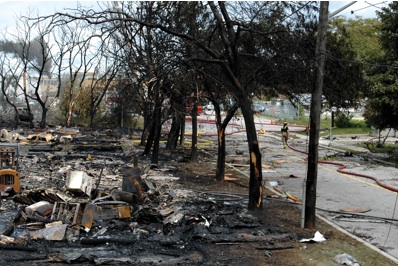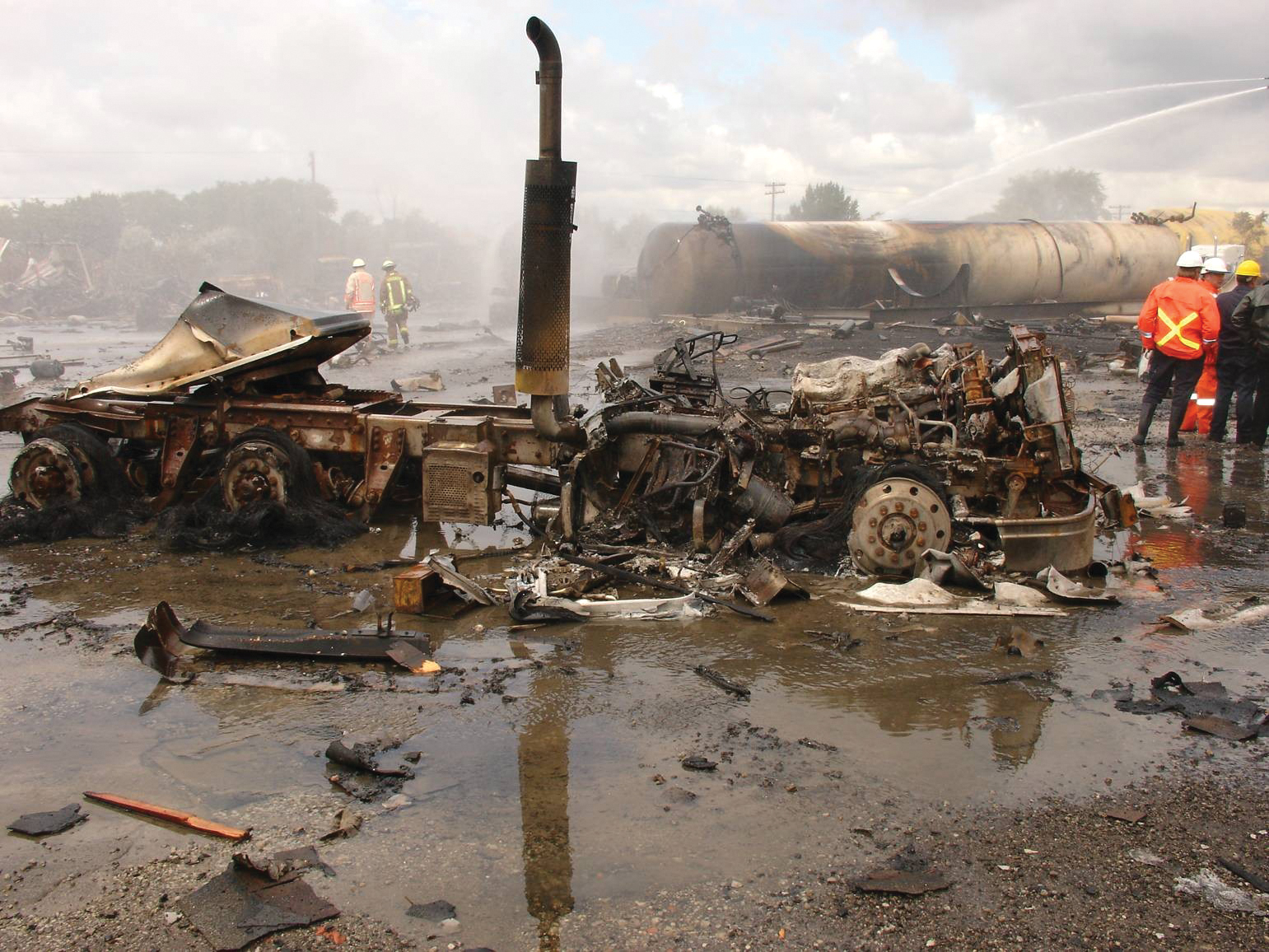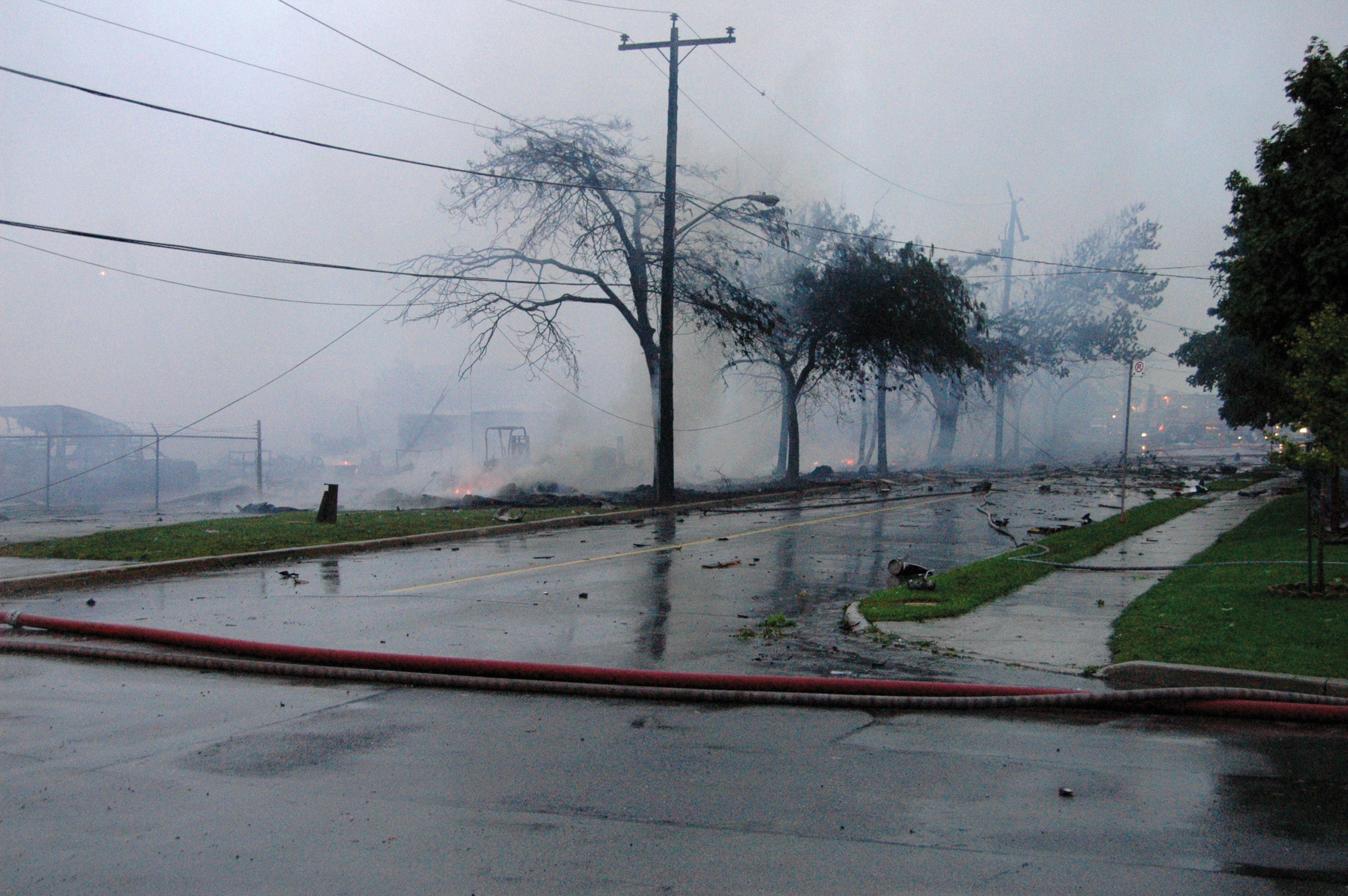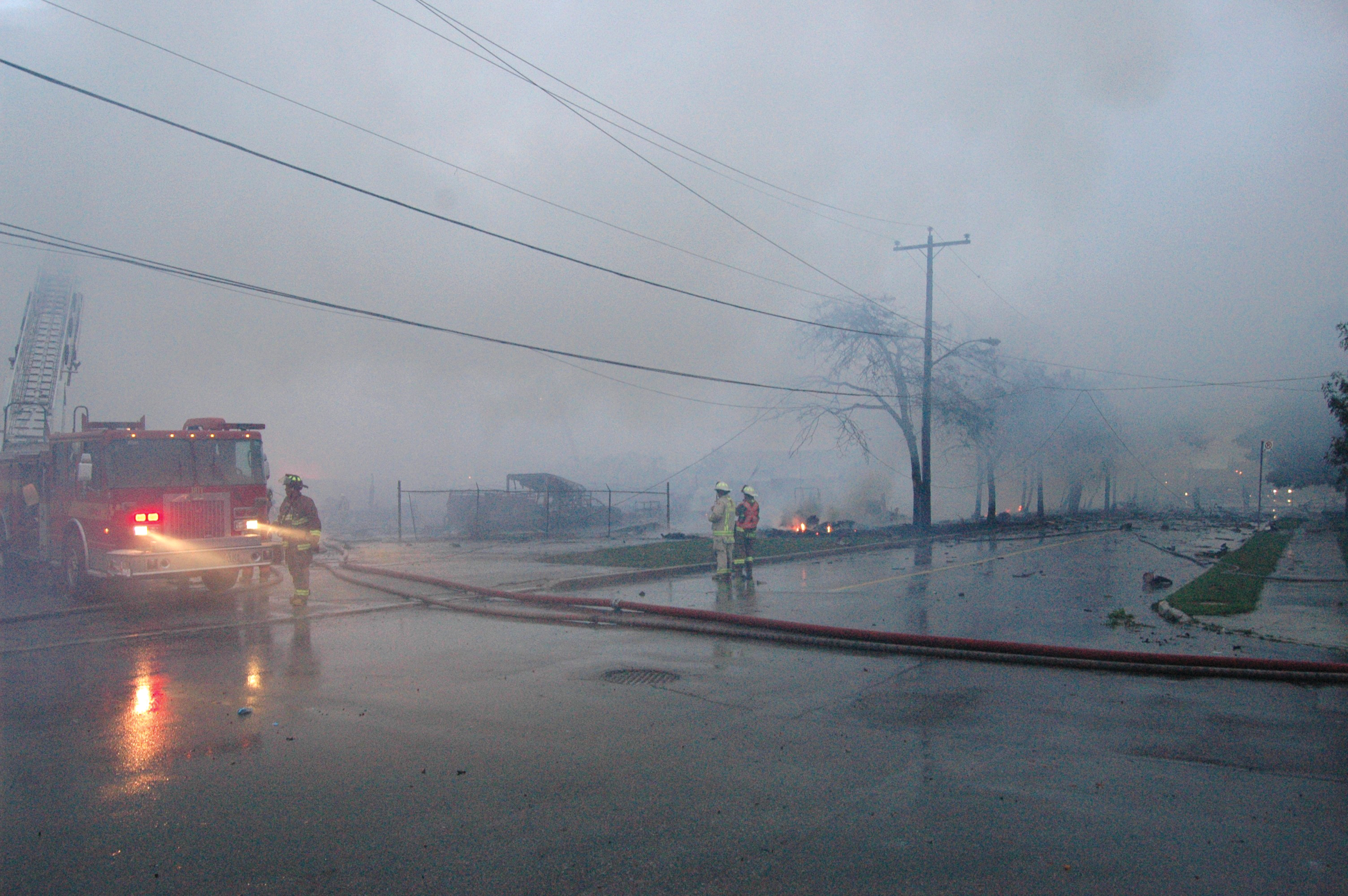
News
Propane aftermath
 CURRENT ISSUE
CURRENT ISSUE
Propane aftermath
Sunrise incident leads to improved safety measures.
March 27, 2009
By
Laura King
It’s ironic that Frank Lamie, Toronto’sdeputy chief for fire prevention and public education, was among the first on the scene of the massive Sunrise Propane explosion in the early hours of Sunday, Aug. 10. Lamie, who lives in Thornhill, about 10 kilometres from the Sunrise Propane site in north Toronto, had been woken up just before 4 a.m. by the
vibrations from the explosions, he believes.
 |
|
| Investigators spent 35 days at the north-Toronto site of the Sunrise Propane explosion and fire in which an employee was killed and a Toronto firefighter died. Cause of the incident has not been determined.
Photo courtesy Toronto Fire Services.
|
Months after the blast, Lamie carefully chooses the words that accompany his PowerPoint presentation on the incident, aware of a pending class-action lawsuit but still leaving members of the Canadian Fire Safety Association shaking their heads over the sheer devastation.
Lamie, whose day-to-day focus is fire prevention and public education, was flabbergasted by what he found at the Sunrise site at 54 Murray Rd. in the former city of North York. The property was licensed for just two propane storage tanks but was littered with thousands of 33-pound propane cylinders and hundreds of 100-pound tanks most often used for heat at construction sites. No one knew whether the cylinders were empty or full of propane. There were tanker trucks on site and it wasn’t clear what they contained, if anything. The company owner couldn’t immediately be located and there was no available paperwork on site to indicate what was in the various tanks.
Explosions were happening every five to 15 seconds. Debris rained down 325 metres away. Soffits and fascia were blown off of nearby homes. Sheets of drywall dropped from ceilings. The steel front door of one house was blown off, flipped 90 degrees and lodged in the hallway. A piece of a tanker truck ended up in a bus shelter a kilometre away; the end of another tanker blew off and lodged in a City of Toronto road-salt storage dome 350 metres away and a third piece of a tanker was embedded in an office building 250 metres away. The timing of the blast, early on a summer Sunday morning, likely spared dozens of lives, Laimie says.
Headstones at a nearby cemetery were damaged by shrapnel. Asbestos from pipe wrapping blew over a large area to the east of the site, affecting 580 homes and causing panic among residents.
Buildings in a 1.8-kilometre radius were evacuated; more than 10,000 people were forced to leave their homes, many taken by TTC bus to temporary shelter at York University.
 |
|
| Tanker trucks and propane cylinders litter the site of the Aug. 10 Sunrise Propane explosion and fire as investigators sift through the rubble.
Photo courtesy Toronto Fire Services.
|
Highway 401 was closed and CN and GO trains were shut down for fear of propane cylinders rocketing down the rail line. Planes at nearby Pearson International Airport were grounded out of concern that exploding propane cylinders that were flying hundreds of metres into the air could strike one of them.
Still, while media reports in February – six months after the blast – focused on displaced residents and legal wrangling among politicians and agencies over cleanup bills, Toronto Fire Services is focusing on the good that came from the Sunrise incident and the speed at which regulations surrounding propane handling, transport and storage have changed.
By the time Deputy Chief Lamie made his presentation to the CFSA in mid-January, a provincially ordered review of the incident by professional engineers Michael Birk, an expert in BLEVEs (boiling liquid expanding vapour explosions) and Suzanne Katz, a former director and chief inspector for gas safety for the B.C. government, had resulted in the implementation of 30 recommendations with 10 more under review.
According to the report, more than 300,000 Ontario businesses and households consume about 650 million kilograms of propane every year in barbeques and vehicles and to provide heat for construction sites, farms and rural homes. More than 5,000 people are employed in the propane industry and about 5,800 storage facilities are licensed for propane storage in Ontario. The Technical Standards and Safety Authority oversees propane safety in Ontario and was the target of many of the recommendations in the report.
A fact sheet on the recommendations is online at www.sbe.gov.on.ca. The status of the recommendations is updated regularly.
The TSSA’s action plan on propane handling, storage and transport is available at www.tssa.org/home/default.asp?loc1=home. The plan lists all 40 of the review panel’s recommendations, indicates which ones fall under TSSA authority and describes status/actions and timing of changes.
The review was ordered by the Ontario government on Aug. 28, 18 days after the blast, and was completed Nov. 7, by which time some new measures were already in place. In August, Ontario’s Minister of Small Business and Consumer Services asked the TSSA to audit propane facilities. Phase 1 involved a re-audit of all large propane facilities with permanent storage capacity by Aug. 31. Phase 2, involving smaller storage facilities, was completed by Dec. 31.
 |
|
| Debris from the Sunrise Propane explosion landed hundreds of metres away, damaging homes and properties.
Photo courtesy Toronto Fire Services.
|
Amendments were made in the fall to the Propane Storage and Handling Regulation and Fuel Industry Certificates Regulation, both under the Technical Standards and Safety Act, 2000. They include:
• Inspections: Propane facilities will be inspected annually or more frequently.
• Licensing: Propane facilities will be required to create, implement and update risk and safety management plans and seek fire service approval of applications for new and expanded facilities. Municipalities will also be able to provide input on new and modified facilities where they may impact land-use planning.
• Operations: Propane operators must declare and abide by limits relating to the total amount of storage and inventory of propane and keep records to demonstrate maintenance of fire safety equipment and systems.
• Qualifications: Propane safety trainers will be required to have both practical and theoretical knowledge of propane. Propane facility employees, as well as at least one partner, director or officer of every company operating a propane facility, will be required to carry and produce proof of their credentials, upon request, and their training will be reviewed at least every three years.
• Public interaction: Emergency preparedness sections of the risk and safety management plans for propane facilities will be made available to the public.
A discussion paper that preceded the review is available at propanesafetyreview.ca. It focuses on “propane-related legislation and regulations compared with internationally recognized best practices.”
The full report by the engineers is available at www.propanesafetyreview.ca/ .
Meanwhile, the TSSA is also the target of some public criticism and frustration. Toronto city councillor Maria Augimeri, in whose ward the explosion occurred, told the Toronto Star in February that the “TSSA clearly wasn’t doing its job.”
And, because the TSSA can’t be sued for negligence, Toronto law firm Stevensons LLP, which represents thousands of residents affected by the blast was to ask a judge in March to allow a $300-million class-action lawsuit to proceed against Sunrise Propane and landowner Teskey Concrete Co. Ltd.
Bizarrely, Sunrise Propane’s website was still functioning at press time, promoting its 24-hour dispatch for customers. Sunrise’s licence was revoked shortly after the explosion and the site remains a shambles in a neighbourhood where homes are still boarded up and street lights were finally turned back on in February.
As Deputy Chief Lamie noted, fire officials and those from other agencies spent 35 days at the Sunrise Propane site trying to piece together the cause of the tragedy (the cause hadn’t been determined at press time) that killed an employee and during which a fatal heart attack felled Toronto District Chief Bob Leek. By 4:05 a.m. the incident had been upgraded to a fifth alarm and a sixth alarm was called about an hour later.
 |
|
| Forty recommendations about the transportation, storage and handling of propane from a report on the Sunrise Propane fire and explosion have been implemented or are under review.
Photo courtesy Toronto Fire Services.
|
Firefighters were dealing with BLEVEs, with unknown substances, with intense heat and flying debris, and fought the inferno with unmanned master streams pumping 500 gallons per minute.
Lamie’s frustration over regulatory violations at the Sunrise site, the danger to firefighters and nearby residents, and the lack of accountability in the aftermath was evident as he spoke to Canadian Fire Safety Association members.
Lamie’s presentation about the incident is in demand – he’s making the rounds of fire chiefs association conferences starting this spring. The photos alone, detailing the magnitude of the devastation, are worth the price of admission.
Daryl Fuglerud, Toronto Fire’s deputy chief of staff services, administration and communications, also spoke to the CFSA about his experience at the Emergency Operations Centre during the Sunrise incident.
He said lessons learned from the 2003 Ontario blackout helped city, fire and emergency officials better cope with the magnitude of the propane explosion and noted that since amalgamation of East York, Etobicoke, North York, Scarborough and York into Toronto in 1998, emergency responders have had to deal with larger incidents that require the co-operation of more agencies and more people.
“It’s simple things like how work stations need to be set up,” he said. “The most important thing is how we interact with each other.”
Fuglerud said Incidents like the SARS outbreak of 2003 and the blackout have forced agencies to work together and work better together. For example, fire. EMS and police officials now meet once a month to discuss issues and incidents. The personal relationships that grow from those meetings have led to improved relations during emergencies, he said.
Print this page